Camden is the oldest inland city and fourth oldest city in South Carolina. It is near the center of the Cofitachequi chiefdom that existed in the 1500s.[5] In 1730, Camden became part of a township plan ordered by King George II.
Kershaw County’s official web site states, “Originally laid out in 1732 as the town of Fredericksburg in the Wateree River swamp (south of the present town) when King George III ordered eleven inland townships established along South Carolina’s rivers, few of the area settlers chose to take lots surveyed in the town, choosing the higher ground to the north. The township soon disappeared.” In 1758, Joseph Kershaw, from Yorkshire, England came into the township, established a store and renamed the town Pine Tree Hill.
Camden became the inland trade center in the colony. Kershaw suggested that the town be renamed Camden, in honor of Lord Camden, the champion of colonial rights. May 1780 brought the American Revolution to Charleston, South Carolina, and Charleston fell. Lord Charles Cornwallis and 2,500 of his troops marched to Camden and established there the main British supply post for the Southern campaign.
The Battle of Camden, the worst American defeat of the Revolution, was fought on August 16, 1780 in Camden, and the Battle of Hobkirk Hill was fought between around 1,400 American troops led by General Nathanael Greene and 950 British soldiers led by Lord Francis Rawdon on April 25, 1781. The latter battle was a costly win for the British, and forced them to leave Camden.
Camden, although not involved directly with the Civil War, did send a few generals. Hero of the American Civil War Richard Rowland Kirkland – ‘The Angel of Marye’s Heights’ – is interred in the Old Quaker Cemetery. Camden moved on from the war, and in 1885 it became a place where rich Northern families would spend the winter.
The town became associated with many equestrian activities, and is now the home of the third oldest active polo field in America. In the winter, more than 1,500 thoroughbreds call the field home. According to Kershaw County’s web site, “Horse related activities became very popular. That interest in equine activities has continued and today the horse industry is a major part of the county economy. For that reason, the county is known as the ‘Steeplechase Capital of the World’.” [Courtesy of Wikipedia – History of Camden, SC]
—————————————————————
Camden, the City on the Wateree
After paying homage to Camden’s historic past, its role in the Revolutionary War, and the famed visit of Lafayette, reporter John I. Green turned his attention to the community as it appeared to him in December of 1889* Although still an agricultural-commercial center, the state’s oldest inland town was fast becoming something of a health resort. In this instance, we are told, a unique gravel and sand soil produced a remarkably dry climate, and this same sand also filtered the drinking water, making it extremely pure. In any case, inns and hotels were developing to cater to winter tourists from the North, none of them more unusual, it would seem, than Uphton Court.
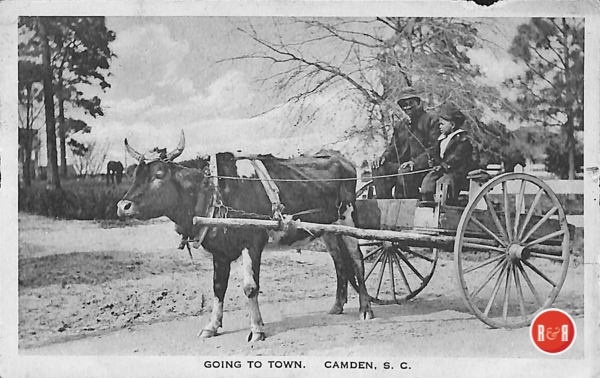
Postcard view of how rural farm hands once came into Camden to shop. Courtesy of the AFLLC Collection – 2017
Camden stands on a well-drained plateau about two hundred and fifty feet above the sea and seventy-five feet above the Wateree River. It is beautifully laid out. The streets are unusually broad and run north and south. There are several public squares and parks,
which are well shaded and well kept. The surrounding country produces a great variety of crops, the forests along the river furnish all sorts of hard woods, and the pinelands are a boundless field to the enterprising lumberman and distiller. While cotton and rice are the commercial staples, they are by no means the only crops which flourish here. All sorts of grains are cultivated to perfection, and any kind of vegetable which can be grown in the South thrives in the fields of Kershaw. Both the soil and the climate—particularly the latter—are especially adapted to grape culture, and a little enterprise in the matter of vineyards will give proof of the capabilities of the land. It will not be long before canning factories will be erected, for there are exceptional inducements for such enterprises. And soon flourishing vineyards will dot the county, and streams of abundance will pour from their presses.
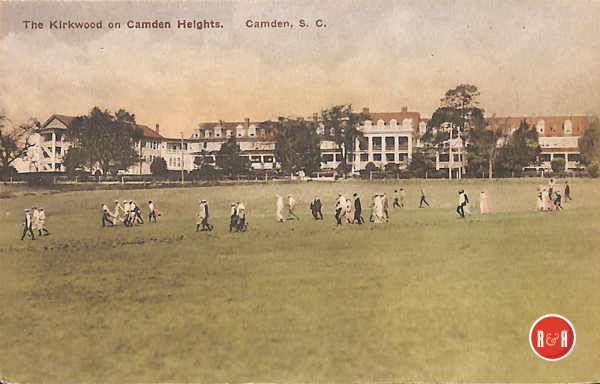
The beautiful Kirkwood Inn. Postcard image courtesy of the AFLLC Collection – 2017
Camden stands at the head of navigation on the Wateree, and there is no reason why a line of steamboats on this stream would not pay. One would have been built long ago but for the lack of capital. The distance by rail to Charleston is 137 miles, Columbia 60 and Rock Hill 60 miles.
Give a place a score of railroads and a soil as fertile as the lands of the Nile, and it is a failure if it is not healthy. The climate of this place is its greatest drawing card. In these days, when every village with a little spring is advertising itself as a wonderful health resort, statistics are of more interest than all-healing claims. Here are a few figures which speak more eloquently than the most gorgeous superlatives: Camden is in latitude 34 deg 17 min and 80 deg 83 min west longitude. The mean temperature for thirty-two years was as follows—spring 61.90°, summer 79.32° autumn 62.26°, winter 45.16°; annual 62.16°. The average rainfall for twenty years was 4.2222 inches* The average death rate was 12V2 per thousand. These data were furnished the Smithsonian Institution by Mr. Colin McRae, the observer at this place for the national signal service. In summer pleasant breezes moderate the warmest weather, and the nights are usually cool. A light snow falls about every alternate year. But read what another has to say. Dr. Willard Parker, Jr., writing in the Medical Record, says of Camden: Owing to the peculiar nature of the soil, all moisture is almost immediately absorbed, so that the air is remarkably dry. While there are a few cold days, we find none of penetrating cold; nor, on the other hand, do we have any of that enervating heat met with in places farther south. The pine trees and turpentine stills in the vicinity give the air a turebinthine odor, which is very soothing to those harassed by a cough. My two children, neither of whom had ever before passed a winter free from croup, showed not a symptom of it, though exposed in all weathers.
Dr. S. Baruch of 44 East 60th Street, New York, writing to the proprietor of Uphton Court, says: “You may refer to me as regards the climate of Camden for consumption, rheumatism, and kidney troubles.” One of the commissioners of the New York State Board of Health writes: “I know Camden well and can truly testify to its high hygienic character. I cannot conceive an epidemic prospering there.”
The Yorkville Enquirer of Feb. 6, 1879 reported – “In Kershaw County most of the negroes who have made contracts for 1879 are working four days a week for their employer and two days a week for themselves. The employer furnishes them houses, rations, and land that they can tend for themselves. They can use his stock to work the land. Those who work for wages alone get from $5-7.00 per month and rations.”
The following from a descriptive pamphlet on Uphton Court is of interest: The healthfulness for which Camden is so justly famed is largely due to the soil, which to a great depth is composed entirely of sand and gravel. This insures the maximum degree of dryness, both of the soil able purity of the drinking water is largely due to the great depth of sand through which it filters. So unusual were the climatic advantages of this place that many sought them even when many inconveniences had to be borne before they were reached. Seven years ago the Hobkirk Inn was opened. It stands on the outskirts of the town near the site of the battle of Hobkirk’s Hill. Capt. E.H. Eldridge, a Northern gentleman, is the proprietor, and from an old-time Southern mansion he has made one of the most comfortable and home-like hostelries in the South. He succeeded from the beginning, and among his guests were many of the wealthiest people of the North and West, some of whom came in their private cars and spent many weeks. The inn has about forty rooms and is luxurious and cosy throughout. The management caters only to tourists who desire to spend several weeks, at least, of the season here. The first question which one who has been to Camden asks anyone whom he chances to meet is: “Have you been to Uphton Court?” This is a hotel which is not a hotel. I cannot better explain the paradox than by a bit of sketching. A grand old Southern mansion that seems to be sleeping in the sunshine. On three sides broad piazzas. In front a garden filled with choice shrubs and flowers which seem to woo one to stray among the inviting walks and bowers. A little distance to the southeast a grove of towering pines, with a band stand and a profusion of seats and swings.
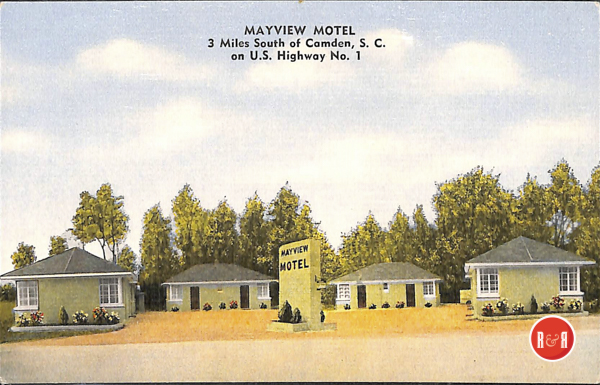
Not all of Camden’s tourist stayed in the grand hotels. Courtesy of the AFLLC Collection – 2017
And then you meet your hostess. Her manner is grace itself and a warm welcome beams from her eyes. You feel at home in a moment. Yes, those are the words, “at home.” Eaces from brushes of the old masters smile upon you from the walls. Exquisite bric-a-brac is scattered about in profusion, rare and curious volumes fill the bookcases, and the reading table is covered with periodicals and magazines from both continents. The chairs and lounges are of the past generation and recall the days when there was no hurry and bustle, and everyone took his ease at leisure. In the dining room it is the same picture in a different light. The antique silver, the rare china, are all in keeping with what you have already seen. To complete the effect, the waiters are all negroes, who almost anticipate your every wish. This is Uphton Court. It is the result of an elegant woman’s whim. Mrs. Perkins, the “proprietor,” as she styles herself, is a descendant of the old aristocracy, but is
- Postcard image of the PO courtesy of the AFLLC Collection – 2017
- Early postcard view of the street, ca. 1910s. Courtesy of the AFLLC Collection – 2017
something of a cosmopolitan in taste. She has spent many years at the North and in Europe, and those who visit her charming “hotel” will find every luxury of today amidst surroundings of the past. Her descriptive circular is a little volume from her own graceful pen and is a gem of the bookmakers’ art. There are other hotels here where the traveler of modest means may get the worth of his money. The Latham House, under the management of Mr. S.B. Latham, has an enjoyable patronage and the Blanton House does a good business.
Now that this place is easily reached from every quarter of the nation, the enterprising hotel men of the country would do well to investigate its claims as an all-the-year-round resort. The tourist can find no better drives in the country, and the hunting and fishing are excellent. Every kind of game found in the South abounds in the fields and forests, from the pheasant and duck to the wild turkey and deer of the river swamps. A mammoth hotel will soon be a necessity.
The population of Camden, including Kirkwood, a suburb which is but a continuation of the town proper, is about 2,500. Despite the many obstacles which existed heretofore, the trade of Camden is thriving, and she makes as good a showing as many of her more fortunately located sisters. About 20,000 bales of cotton are shipped annually, and the rice crop runs up into the tens of thousands. The turpentine business is a large industry in itself and centres here. From the most conservative estimates it is safe to say that over a million and a quarter dollars of business is done annually. The merchants are progressive and conduct their business on modern lines. The old-time stores have been replaced by modern ones, and the till in the counters has given way to the most improved cash registers.
For the information of any who desire to engage in business here, the following directory of the business houses is given, showing how the trade is distributed: General merchandise—N.T. Purdy & Co., P.T. Villepigue, A.D. Kennedy, Baum Bros. & Stein, J.C. Man, P. Tobias, S.M. Wilson, John R. Goodale & Son, M.S. Bambeig, D. Wolfe, E.H. Dibble, T.M. Shannon, and Isadore Wolfe.
Wholesale grocers—Springs, Heath & Co. and H.G. Carrison.
Dry goods—W.E. Johnson, Jr., Hirsch Bros., and B. Rich.
Drugs, paints, and oils—A. A. Moore, F.L. Zemp and EM. Zemp.
Retail grocers—V.E. Deepass, Henry Man, Smyrie & Halsell, W.J. Jones, J.E Arthur, J.W. Blakeney, J.S. Rhame, J.E. Vaughn, J.J. Watkins, J.T. Nettles, and M. Lollis.
Furniture—Baum Bros. & Stein, D. Wolfe, and M.S. Bamberg.
Buggies, wagons, etc.—Smith & Hall, S.B. Latham, and Baum Bros. & Stein. Hardware—A.D. Kennedy, H.G. Carrison, and John R. Goodale & Son. Shoes, hats, and clothing—Zemp Bros.
Shoes—E.B. Capers.
Millinery—Mrs. T.B. Walker, Miss Kate Meredith, and Mrs. S. Tweed. Books, jewelry, cutlery, sewing machines, and fancy goods—G.G. Young. Jewelry—J.M. LeGrand.
Liquors, tobacco, etc.—A.M. Rosenbeiger (also restaurant and billiard parlor), W. Geisenheimer, S.B. Latham, B.F. Hate, and Smyrie & Halsell.
Bakery—Robert Singleton.
Saddlery and harness—W.M. Hinson and Henry Wilson.
Undertakers—R.J. McCreight & Son and Smith & Hale.
Sewing machines—J.C. Reville and T.J. Rodgers.
Gunsmith—A.J. Freitag.
Livery and sale stables—S.R. Latham, W. A. Armstrong, and J.C. Cottrell. Cotton buyers—Springs, Heath & Co. and J.B. Stedman.
Auctioneer—J.S. Meroney.
Insurance—Williams & Williams (fire) and Coutey & DeSaussure (life).
The Bank of Camden has made a record which, its officers say, surpasses that of any other in the State. This institution began business on August 1,1888, with a capital of $25,000. For six months it did business on a paid in capital of $6,250. The first year it paid a dividend of 10 per cent and placed 6 per cent to its surplus account. The estimated average deposits are $50,000. The officers are H.G. Carrison, president; S.C. Clyburn, vice president; C.H. Yates, cashier; directors, H. G. Carrison, S.C. Clyburn, P.T. Villepigue, A.D. Kennedy, N.T. Purdy, W.M. Shannon, and John C. Man.
The Yorkville Enquirer reported on July 11, 1872 – “A hook and ladder company has recently been organized at Camden with Dr. A.A. Moore, a former Yorkville citizens, as foreman.”
The Yorkville Enquirer reported on Oct. 9, 1873 – “Mr. John Kershaw has sold his interest in the Camden Journal to W.D. Trantham, and T.T. Hay. Gen. J.B. Kershaw the Editor, for sometime, has severed his connecting with the paper.”
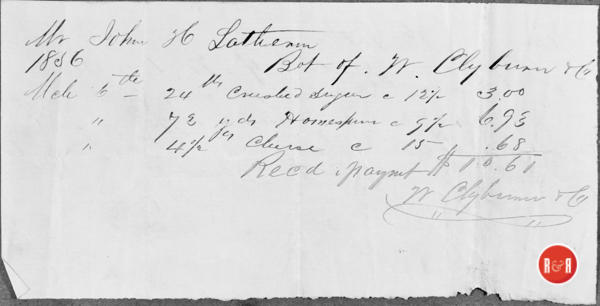
Faulkner Collection – 2018
The Building and Loan Association was organized in 1883 with 400 shares. This number has been increased to 700. It has loaned $40,000, and its first series of shares have an accrued value of about 55 per cent. The second series has been running about two-and-half years. The outlook is bright, and the shares are increasing in value. The officers of the Association are: P.T. Villepigue, president; A. D. Kennedy, vice president; directors, P.T. Villepigue, A.D. Kennedy, S.M. Rosenberger, F.M. Zemp, C.J. Shannon, J.C. Man, and G. Geisenheimer. The Association has never lost anything.
The Board of Trade is an organization on which the town must largely depend for its advancement. The officers are: A.D. Kennedy, president; H. Baum, vice president; N.T. Purdy, treasurer; and John W. Corbett, secretary.
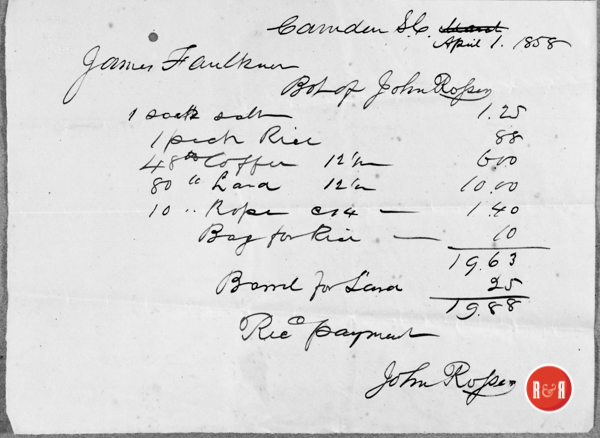
Receipts for the Clyburn Co., and John Roper of Camden, S.C. from the Faulkner Collection – 2018
A fine opera house was built in 1885. It has a frontage of 60 feet, a depth of 70 feet, and is three stories high. It is one of the handsomest theatres in the State. The scenery is very fine, and the auditorium is fitted with very comfortable folding chairs. The building and fittings cost $21,000, $15,000 of which is the only bonded debt that the town has. The fire department consists of one steamer, two hand engines, and a hook and ladder company. An abundant water supply is furnished by capacious fire wells. The total levy of taxes is only three mills, which pays all current expenses and the interest on the town’s debt. The average rate of insurance is 1% per cent.
There is a fine graded school which was established about two years ago. The attendance numbers 175. A large and competent corps of teachers are in charge. The following is a list of the faculty: A.L. Moore, superintendent; teachers, Mrs. Mary C. Thomason, Mrs. M. A. Shannon, Mrs. N.S. Withers, Miss Lizzie Stoney, and Miss Anna Davis. There is a negro graded school of which W.W. Carter is principal. There are also several private schools which are well patronized.
Nearly all of the religious denominations have churches. The Presbyterian Church is the oldest house of worship in the town. It has a large membership. The pastor is the Rev. WW. Wells. The Methodist Church is a handsome brick building. The pastor is the eloquent E.J. Meynardie. The Episcopal Church, which has been completed recently, is a beautiful Gothic structure. The rector is the Rev. J.M. Stoney. The Baptist Church has a very large membership. The pastor is the Rev. Paul V. Bomar. The Bible Society is doing a good work. The depository is at the store of P.T. Villepigue, who is secretary and treasurer. Judge J.B. Kershaw is the president.
The Camden Bar has produced an unusual amount of talent and has sent forth many men to fill high places. The following is the personnel as it stands today: Gen. John D. Kennedy (late consul general at Shanghai), J. Thomwell Hay, Capt. W.M. Shannon, Col. P.H. Nelson (solicitor for the 5th district), W.D. Trantham, E.D. Blakeney, C.L. Winkler, J.D. Dunlap, T.H. Clarke, B.B. Clarke, TJ. Kirkland, and L.A. Wittkowskey.
The physicians are: A.W. Burnett, A.A. Moore, John W. Corbett, D.L. DeSaussure, and EL. Zemp; dentist, T.H. Alexander. If other evidence were wanting, the mere fact that Camden has three newspapers would be a guarantee that there was a large amount of culture in town and country.
The Wateree Messenger was founded in 1885 by Mr. C.W. Birchmore, an energetic journalist and active citizen, and has grown steadily in circulation and influence. The Camden Journal, established in 1827, has a rather amusing incident connected with the history of its management. Mr. G.G. Alexander was its proprietor when Harrison was elected and was appointed postmaster to supersede Mr. D.C. Kirkley, the Democratic incumbent. These two gentlemen made a happy exchange of places, reversing the politics of both, and it puzzles the people here to ascertain whether the town has lost or gained by the change, or is “about even.” The Camden Chronicle has recently come under the management of Mr. B.B. Clarke, a young lawyer of exceptionable ability. The Chronicle’s editorials display unusual journalistic talent and are full of promises.
There are two cornet bands in the place, one white and one colored, a flourishing cavalry company, an infantry company, and a flourishing Base Ball Association owning a park where the best amateur games of the State are played. The town will soon issue $10,000 worth of bonds for internal improvements. The Knights of Honor, the Ancient Order of United Workmen, the American Legion of Honor, the Knights of the Golden Rule, and the Freemasons have lodges here. The Kirkwood Reading Club, composed of old and young of both sexes of Camden and Kirkwood, is giving its members valuable literature and literary entertainments.
Efforts are being made to establish a $100,000 cotton factory. If half of this amount is raised by local capitalists the remainder will be furnished by Northerners. All but a few thousand dollars of the requisite amount has been subscribed, and it is to be hoped, for the benefit of the whole town, that some enterprising citizen will not let such an important enterprise collapse for the want of two or three thousand dollars. The slightest retrograde movement at this time would be a great misfortune. The eyes of all are on Camden now, and the manner in which she deals with her opportunities will have much to do in making or destroying confidence in her people. If one factory is established, others will soon follow, but the first step is always the most difficult. These people should always remember that confidence in the resources of a place must begin at home. It would be awkward to ask others to invest without first taking the initial step.
With the fruits and grapes and vegetables which cover the fields on every hand and the grand treasures of the surrounding forests, factories will surely come—if a beginning is made. One of the many great natural advantages possessed by Camden is the valuable water-powers almost at her door. The great Wateree Canal, built by the State before the war, is only about seven miles distant and will furnish unlimited power.
Reprinted from South Carolina in the 1880s: A Gazetteer by J.H. Moore, Sandlapper Publishing Company – 1989
Stay Connected
Explore history, houses, and stories across S.C. Your membership provides you with updates on regional topics, information on historic research, preservation, and monthly feature articles. But remember R&R wants to hear from you and assist in preserving your own family genealogy and memorabilia.
Visit the Southern Queries – Forum to receive assistance in answering questions, discuss genealogy, and enjoy exploring preservation topics with other members. Also listed are several history and genealogical researchers for hire.
User comments welcome — post at the bottom of this page.

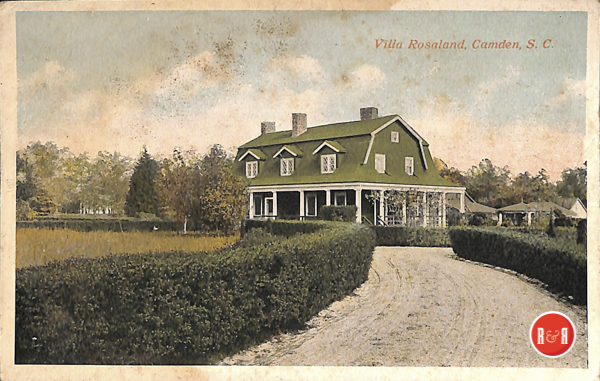
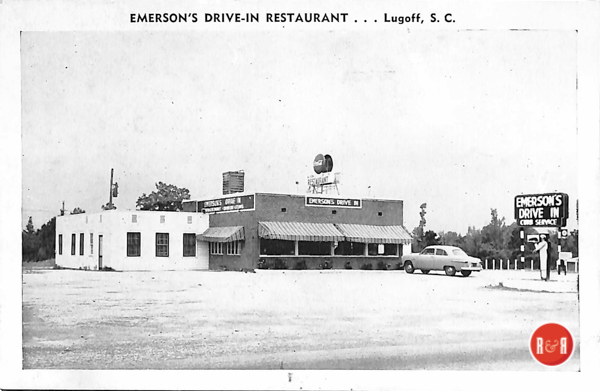
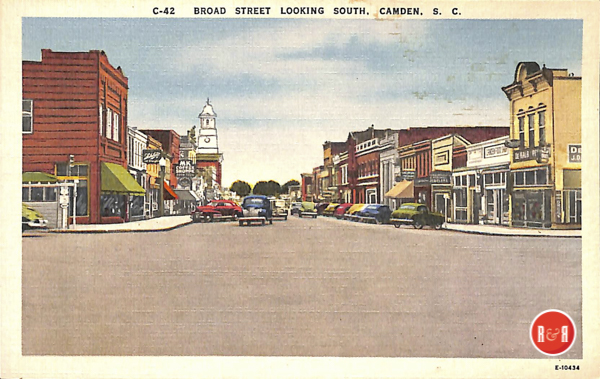
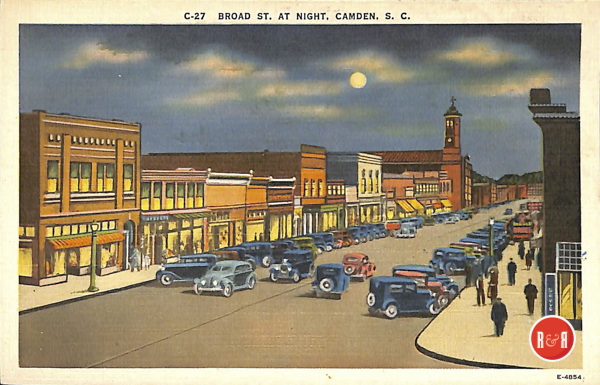
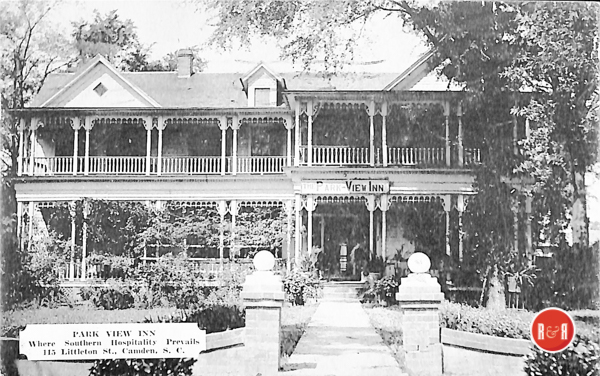
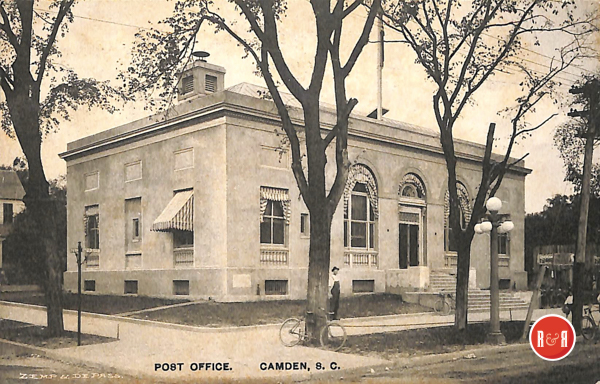
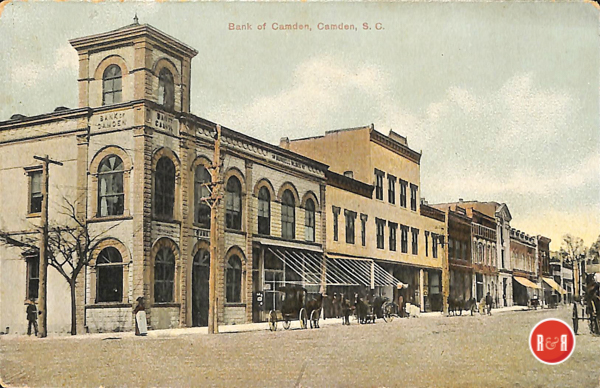

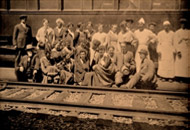
Share Your Comments & Feedback: